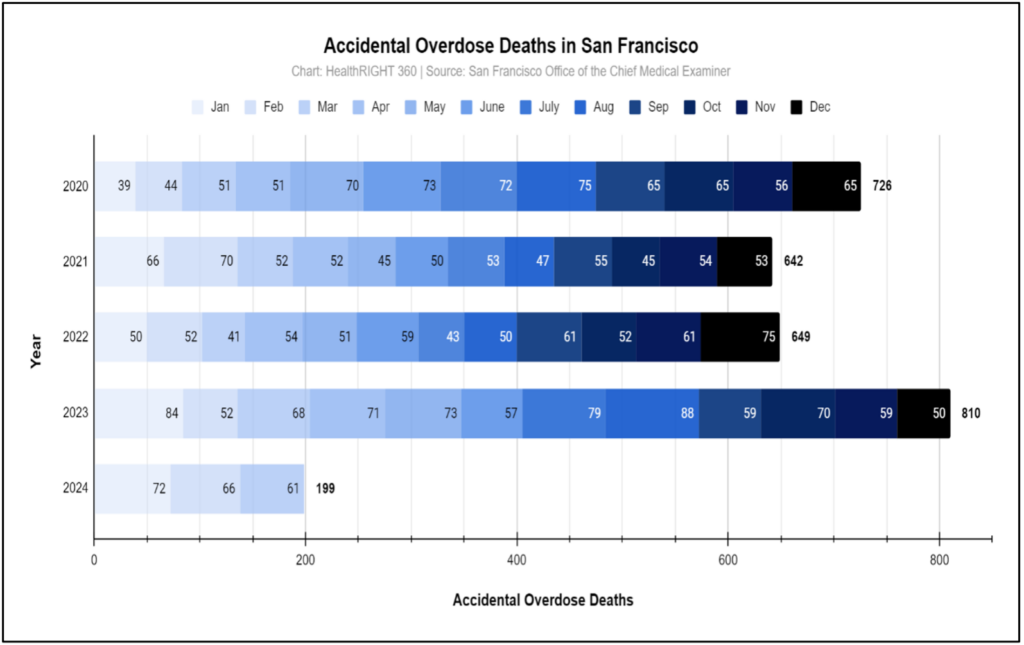San Francisco, CA — According to provisional overdose death counts – data made available by the Centers for Disease Control and Prevention and the National Center for Health Statistics – the United States has begun to witness a slight decline in accidental overdose mortality rates.[1] While the most recently available data shows a national decline of 3.1 percent from 2022 to 2023, this perceived stabilization does not imply an overall improvement. The high number of overdose deaths in the country remains a critical public health issue, with levels continuing at historically high rates and racial disparities persisting.[2] During the same period, California and San Francisco have not mirrored this potential plateau. The state experienced a 4.06 percent increase in accidental overdose deaths, and San Francisco is facing a dramatically different and more severe situation, with a 24.8 percent increase (see Figure 2).[3]
Figure 1. Annual Accidental Overdose Deaths
| Annual Accidental Overdose Deaths | |||
| Year | United States | California | San Francisco |
| 2020 | 93,655 | 9,575 | 726 |
| 2021 | 109,179 | 11,930 | 642 |
| 2022 | 111,029 | 12,214 | 649 |
| 2023 | 107,543 | 12,710 | 810 |
This divergence underscores the complex, multifaceted nature of the overdose crisis, which varies significantly across regions. These data highlight an urgent need for localized strategies that are not only evidence-based but are also deeply responsive to the specific needs and circumstances of individual communities and center the desires and experiences of people who use drugs.
Overdose rates in our community have surged, a troubling trend that contrasts sharply with a provisional national decrease. This local escalation demonstrates how policy environments and an inability to move beyond longstanding views on drug use can critically shape public health outcomes. This situation calls for a creative and unified approach to public health policy and practice, emphasizing the necessity of tailoring interventions to meet unique local challenges.
Our response to this emergency must be innovative and relentless. We need to deploy every available evidence-based tool and continuously refine our strategies based on emerging science. Our ability to respond promptly is supported by San Francisco’s Office of the Chief Medical Examiner, which uniquely reports overdose data on a monthly basis, allowing us to adapt and refine our strategies with agility, whereas other jurisdictions have a more significant lag.
San Francisco has made notable strides in expanding access to medication for opioid use disorder treatment (MOUD), an advancement that has undoubtedly helped to mitigate what could have been an even more severe increase in overdose fatalities. While these incremental improvements are valuable, they are insufficient on their own; a more comprehensive and aggressive approach is required to substantially reduce overdose mortality.
Figure 2. Accidental Overdose Deaths in San Francisco by Month

According to preliminary data, there were 61 overdoses in April, which brings the total for 2024 to 199.
This means not only implementing established evidence-based interventions but also fostering innovation in our approaches. To effectively reduce the high incidence of overdose fatalities, it is critical to establish more low-barrier services, drop-in centers, overdose prevention centers, peer-to-peer services, and overdose notification systems in single-room occupancy and supportive housing settings. These interventions ensure that individuals do not use alone — one of the most significant predictors of overdose mortality. Expanding access to MOUD, contingency management therapy, enhancing harm reduction services, and strengthening community education and support systems are essential steps. Such evidence-based interventions — some with decades of irrefutable, global proof of concept — have the potential to save many lives if properly resourced, scaled to match the crisis, supported consistently, and adhered to with fidelity. Furthermore, solutions must be co-developed with input from directly affected communities, ensuring they are not only effective but also culturally competent and supportive of those most impacted. By doing so, we can build a comprehensive response that not only addresses the immediate challenges of overdoses but also mitigates the underlying factors contributing to the crisis.
To achieve these goals, our organization commits to a spirit of collaboration and determination. We recognize that no single entity can solve this crisis alone; it requires a concerted effort involving healthcare providers, policymakers, community organizations, residents, and people with lived experience. Together, we must be resolute in our commitment, evaluate our progress with rigor, and adapt swiftly to new insights. By uniting our efforts and focusing on creative, evidence-based solutions, we can strive to reverse the devastating impact of the overdose crisis and set a precedent for effective public health response.
About HealthRIGHT 360:
HealthRIGHT 360 is a non-profit provider of substance use disorder treatment, mental health services, and primary care to over 39,000 Californians annually. HealthRIGHT 360 provides care that is compassionate, non-judgmental, and evidence-based. We provide services, regardless of one’s ability to pay; inspired by our belief that healthcare is a right, not a privilege. Learn more about HealthRIGHT 360 and our programs at https://www.healthright360.org/.
[1]Ahmad, FB, Cisewski, JA, Rossen, LM, Sutton P. “Provisional drug overdose death counts.” National Center for Health Statistics. May 15, 2024. https://www.cdc.gov/nchs/nvss/vsrr/drug-overdose-data.htm
[2] Spencer MR, Garnett MF, Miniño AM. Drug overdose deaths in the United States, 2002–2022. NCHS Data Brief, no 491. Hyattsville, MD: National Center for Health Statistics. 2024. DOI: https://dx.doi.org/10.15620/cdc:135849
[3] Rodda, L. “Accidental Overdose Report, Jan 2023 to Mar 2024,” OCME Accidental Overdose Reports, Office of the Chief Medical Examiner, April 11, 2024. https://www.sf.gov/resource/2020/ocme-accidental-overdose-reports
